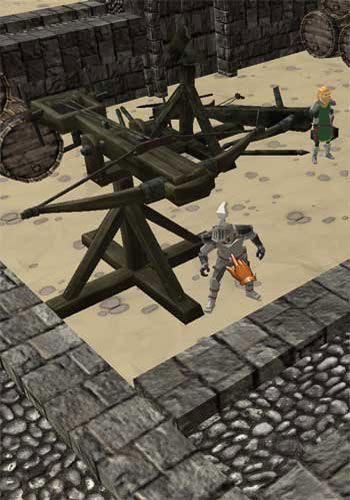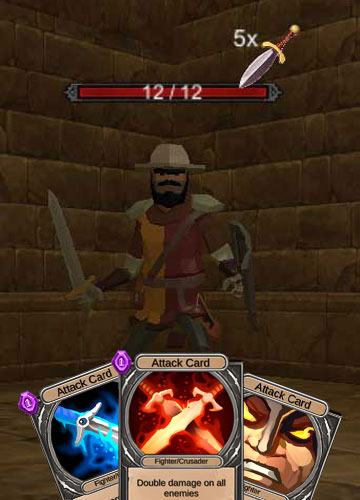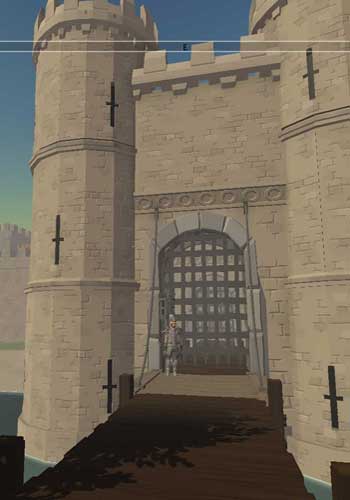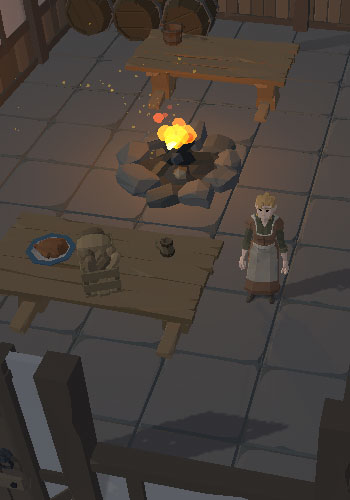
 he trebuchet was a
wooden siege
engine designed to destroy castle walls by throwing
large rocks at them. The engine was constructed using a sturdy base, a long
throwing arm
and a bucket to hold weights. The projectile was connected by a rope to the end
of the
throwing arm while the bucket at the other end of the arm was filled with a
heavy material.
The arm was winched down lifting the bucket into the air and secured in place
while the
projectile was attached. The projectile rested on a flat piece of wood. The
projectile was
connected to the arm and the firing mechanism released. The weight of the bucket
brought
the other end of the arm down and sent the projectile flying into the air. At
the top of
the arc the projectile was released and sent speeding to hit the castle wall.
The direction
of the projectile could be controlled by moving it left and right on the board.
The distance could be controlled by altering the shape of the release pin on the
end of
the arm, the amount of weight in the bucket or the weight of the projectile
itself.
he trebuchet was a
wooden siege
engine designed to destroy castle walls by throwing
large rocks at them. The engine was constructed using a sturdy base, a long
throwing arm
and a bucket to hold weights. The projectile was connected by a rope to the end
of the
throwing arm while the bucket at the other end of the arm was filled with a
heavy material.
The arm was winched down lifting the bucket into the air and secured in place
while the
projectile was attached. The projectile rested on a flat piece of wood. The
projectile was
connected to the arm and the firing mechanism released. The weight of the bucket
brought
the other end of the arm down and sent the projectile flying into the air. At
the top of
the arc the projectile was released and sent speeding to hit the castle wall.
The direction
of the projectile could be controlled by moving it left and right on the board.
The distance could be controlled by altering the shape of the release pin on the
end of
the arm, the amount of weight in the bucket or the weight of the projectile
itself.
Trebuchets came in many shapes and sizes, some having wheels so they could be moved around the siege landscape. Trebuchets were built as kits that could be assembled and disassembled and transported in sections to where they were needed. All the pieces slotted together and were fixed with wooden or metal pegs.
Rocks were not the only things that were thrown by trebuchets. It was common to throw urns filled with flammable material into the castle where many of the buildings were made of wood. The urn had a lit fuse that would have ignited the material when the urn broke. Dead animals were another type of projectile thrown into castles. Animals that were diseased were preferred as they could spread disease if they landed in the castle's water source.
Being constructed of wood made trebuchets vunerable to attack by fire and had to be protected from this danger.
Trebuchet Game (Beta Version)
Take control of a medieval trebuchet to destroy the enemy castle and capture their flag.
Instructions:
- Click the trebuchet or press the space bar to launch the projectile.
- To get the best result wait for the basket to swing back to the left.
- The trebuchet will reload automatically after each shot.
- The game have been tested on desktop IE10, IE11, Chrome and Firefox. It may not work on mobile or other browsers.
- This game in under development and will be improved at a later date.
Page Navigation

More castle pages
Pages in this section
Types of castles

Medieval Castles
Types of castles
- Early Fortifications
- Castles of William the Conqueror
- Earthwork castles
- Motte and bailey castles
- Square keeps
- Shell-Keeps
- Polygonal Keeps
- Concentric Castles
Other details










